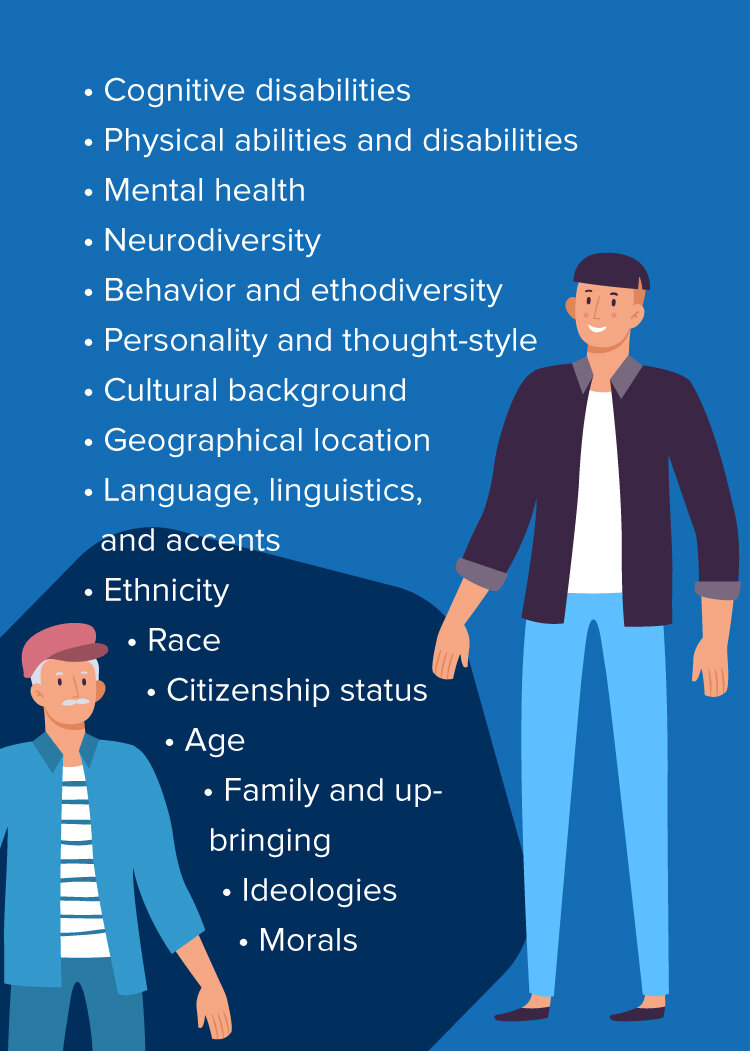Holistic and Long-term View of DE&I
Diversity, equity, and inclusion (DE&I) is all the rage today due to last summer’s protests, which helped to wake up leaders to a critical need that has existed for decades. Yet with any trend comes the possible “fizzle out” factor. Many organizations have tunnel vision; they are being reactive but not looking holistically at how to embed DE&I in their practices and cultures. Is our thinking broad enough, and is our transformation work deep enough to ensure our organizations are sustaining a long-term commitment to diversity, equity, and inclusion? Below we explore this question.
DIVERSITY
First, it is important to start with a proper definition of diversity that goes beyond race, ethnicity, and gender discrimination. We must think about the many other qualities that comprise a diverse workplace to truly understand the multiple experiences of our people.
Take, for example, this list of 34 unique diversity characteristics by Built In:
We appreciate the comprehensiveness of this multifaceted definition of diversity. Think about how many employees you lead on a daily basis and the infinite differences they bring to work that shape not only who they are, but how they show up.
EQUITY
With the above in mind, let’s turn to equity. What is your role as a leader to help those individuals who have been marginalized and historically underrepresented to catch up?
For example, imagine one of your employees was born in a geographical location that is disadvantaged. This person was not exposed to good manners, cooperative play, nor the importance of education. They spent most of their childhood without consistent adult oversight because their parent(s) worked multiple jobs. With these factors at play, they grew up with a lack of resources, support, and opportunity. When this person enters your organization at age 25, they are not on a level playing field when compared to their privileged peers.
What is your civil duty and corporate responsibility to support this person, as well as the many others who continue to be left behind? What partnerships can your organization forge to make a positive impact in the lives of your people?
Earlier this year, the Howard University School of Business received $20 million dollars to create a hospitality leadership center that will build a pipeline of Black professionals, who are traditionally underrepresented in the hospitality industry’s executive ranks. The Marriott family donated this gift to honor Arne Sorenson (the former Marriott International CEO) and his work for creating a culture of opportunity for people of color.
Accounting is another industry that does not reflect the general population: Only 9 percent of the 1.9 million accountants in the United States are Black, and less than 1 percent of CPA roles are held by Black employees, according to the Bureau of Labor Statistics. PwC and Northeastern University are helping to close this equity gap with a master’s in accounting program that allows participants to transfer real-world experience into course credit. Through a blend of online learning and on-the-job application, students receive hands-on practice in an authentic learning environment, without accumulating massive debt.
These are two inspiring examples of recent partnerships that are reshaping the equity landscape for disadvantaged workers. How can your organization follow suit?
INCLUSION
Inclusion is the final piece of the DE&I puzzle. Once you have the right balance of diverse folks in your organization and a culture of equity to help them thrive, here are some ways you can make them feel at home.
Listen to your employees. Every person in your organization brings unique strengths, needs, and preferences, from the pronouns they use to identify themselves to the skills they contribute to their teams. Prove you are listening by eliminating a one-size-fits-all approach to employee development, and instead incorporate individual needs assessments into all training programs. Also, celebrate the differences that exist in your workforce as you learn more about them. Show your people you see and hear them by calling out the many ways their individuality makes your organization better.
Finally, and most importantly, encourage employees to share their stories and their struggles. As more individuals open up, others with similar struggles will feel more comfortable to do the same. Your people will be empowered to let down their guards and feel more safe bringing their authentic selves to work.
Encourage different perspectives. New thinking brings new innovation. During meetings and within project teams, ensure every person represented has an opportunity to speak their mind. Point out how various opinions and experiences contribute to creativity and eliminate groupthink. Do not shy away from conflict; instead, use it as a vehicle for facilitating constructive conversation and nuanced dialogue.
Transform your policies. Hold your organization accountable to inclusivity this year by putting your commitment on paper. Define how your organization, as a living system, will foster inclusivity for all employees. Re-evaluate existing practices to ensure they encourage diverse employees to rise. When your workforce is able to acknowledge each other's stories, struggles, and perspectives, even more privileged individuals will begin to understand and be less resistant to these changes. And continue to hone your culture so that equity is a hallmark of not only your values, but the norms your staff exudes and experiences.
Our passion for advancing diversity, equity, and inclusion in the workplace move us to help our clients evaluate their culture, practices, and strategies to ensure a long-term commitment to DE&I in their organizations. We would love to do the same for you. Contact us today to learn more.




